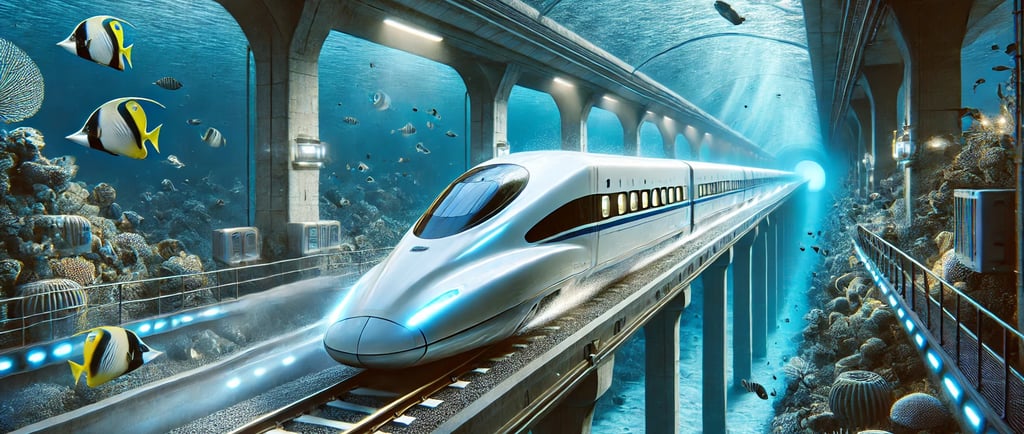Exploring the Mumbai-Ahmedabad Bullet Train: 7 Key Facts About India's First 21 km Undersea Train
🚄 Mumbai-Ahmedabad Bullet Train: India’s First Undersea Rail Project 🌊 India is set to revolutionize transportation with its first 21 km undersea tunnel as part of the Mumbai-Ahmedabad Bullet Train project! 🚆💨 This high-speed marvel will enhance connectivity, reduce travel time, and introduce cutting-edge technology to Indian railways.
NATIONAL


Introduction to the Mumbai-Ahmedabad Bullet Train
The Mumbai-Ahmedabad bullet train project marks a significant milestone in India's railway infrastructure development. This ambitious initiative, featuring the country's first undersea train segment, is not only a hallmark of technological advancement but also a beacon of modern transportation. This blog post aims to present seven key facts about this groundbreaking project, delving into its features, benefits, and overall significance.
1. First Undersea Segment in India
The Mumbai-Ahmedabad bullet train includes a remarkable 21 km undersea section. This segment, situated beneath the Arabian Sea, is a testament to innovative engineering and design. The use of advanced tunneling techniques was necessary to construct this underwater passage, ensuring safety and durability in one of the most challenging environments for railway construction.
2. Reduced Travel Time
One of the most compelling advantages of the Mumbai-Ahmedabad bullet train is its ability to drastically cut down travel time between these two major cities. Currently, the journey takes several hours by conventional train; however, the bullet train will reduce this duration to approximately two hours. Passengers will benefit from unparalleled speed and efficiency, making business and leisure travel more accessible than ever.
3. Environmental Considerations
In an era where environmental sustainability is paramount, the Mumbai-Ahmedabad bullet train project incorporates measures to minimize its ecological impact. The use of electric propulsion reduces greenhouse gas emissions compared to traditional diesel locomotives. Furthermore, the railway’s design emphasized the preservation of natural habitats, showcasing a commitment to environmentally responsible infrastructure development.
4. Economic Catalyst
The bullet train is expected to serve as a catalyst for economic growth in both Mumbai and Ahmedabad. By enhancing connectivity, the project aims to facilitate trade, create jobs, and boost tourism. Economists predict that the improved infrastructure will significantly contribute to the economic landscapes of both cities and stimulate regional development.
5. Technological Innovations
Incorporating cutting-edge technology, the Mumbai-Ahmedabad bullet train will feature state-of-the-art safety systems, ticketing methods, and passenger amenities. The train will operate at speeds exceeding 300 km/h, utilizing Japanese Shinkansen technology, known for its reliability and efficiency. These advancements set a new standard for railway transportation in India, positioning it alongside international benchmarks.
6. Cultural Integration
The bullet train project's influence extends beyond mere transportation; it also aims to integrate cultural exchanges between Mumbai and Ahmedabad. As the train facilitates easier travel, it opens avenues for cultural interactions, tourism experiences, and collaborative ventures. This cultural significance adds depth to its national importance, as it creates a bridge between diverse communities.
7. Future Prospects
As the Mumbai-Ahmedabad bullet train progresses, it offers promising prospects for future railway projects across India. By demonstrating the feasibility of high-speed rail systems, this initiative could pave the way for similar advancements in other regions. The governmental support and public interest generated by this project signal a renewed focus on modernizing the nation's transportation infrastructure.
In conclusion to national news from newsdrishti, the Mumbai-Ahmedabad bullet train is a revolutionary step forward for India's railway system. With its undersea segment, reduced travel times, economic benefits, and technological innovations, it encapsulates the future of transportation in India. Understanding these key facts helps underscore the significance of this trailblazing project in reshaping Indian connectivity.
